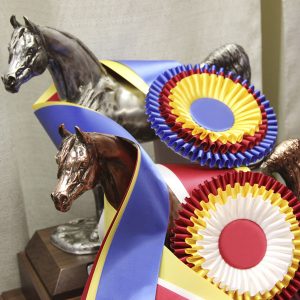
Electrolytes for Top Performance
If you’ve spent any time around a stable during the summer months, then you are probably acquainted with the smell of equine sweat. The sharp odor may be indicative of hard work, but sweat loss also points to a significant management concern: electrolyte supplementation.
Electrolytes perform critical functions in the horse’s body. Most notably, they help regulate nerve and muscle function by carrying electrical impulses between cells. In addition, they assist the body in maintaining proper fluid balance.
Electrolytes are found in three main fluids within the body: fluid within cells, fluid surrounding cells, and blood. In order for the body to function optimally, the concentration of electrolytes in these areas must be kept under strict equilibrium. To achieve this, the body transports electrolytes in the blood and excretes any excess in the urine to maintain a balance between daily intake and output.
Under normal circumstances, well-nourished sedentary horses have little trouble keeping electrolytes at appropriate levels. This does not, however, hold true for the equine athlete. Horses cool themselves during exertion through sweating. Those that are exercised regularly, especially in hot and humid conditions, may lose more electrolytes through sweat than their diet is capable of replacing. In these instances, electrolyte supplementation is important.
To help avoid these conditions, horses should receive electrolyte supplementation during training sessions and competitions in which sweat loss is profuse. The most effective supplements mimic the composition of sweat, containing key electrolytes in the actual amounts lost in sweat. Equine exercise physiologists and nutritionists have succeeded in accurately decoding the composition of sweat. Just as important as electrolyte concentration is electrolyte ratio, that is the concentration of electrolytes compared to each other. Extensive research dictates that a properly balanced electrolyte supplement contains a 1:2:4 ratio of potassium, sodium, and chloride, respectively.
Without electrolyte supplementation, problems may occur in performance horses. Significant electrolyte losses may cause neuromuscular disturbances such as muscle cramping, tying-up, and synchronous diaphragmatic flutter (thumps). Even in their mildest forms these conditions have a negative impact on a horse’s ability to perform and recover. Imbalances in fluids and electrolytes can result in colic and laminitis if dehydration becomes severe.
Because sweat loss and electrolyte depletion go hand-in-hand, horses that are worked intensely are obvious candidates for electrolyte supplementation, as they often sweat profusely during and following a training session.
Sweat loss may be less obvious in horses that perform low-intensity exercise for a long duration (an endurance horse, for instance), because sweat may actually evaporate before it becomes visible. Electrolyte supplementation is just as important in these athletes.
Electrolytes are also crucial in horses that may experience sweat loss and associated stress as a result of other situations such as long trailer rides or changes in the environment. Electrolytes may also be indicated for horses that are dehydrated, but horses must always be given access to water when supplemented with electrolytes.
When choosing an electrolyte supplement, select one that contains the key minerals (sodium, chloride, and potassium) in the ratio previously mentioned. Stay away from those that have an abundance of sugar (glucose or dextrose), as studies in horses have shown that sugar does not increase absorption of electrolytes. If you have questions about the supplement you are currently using or one that you are considering, call the manufacturer and ask specific questions.
Proper electrolyte supplementation is a critical aspect of nutrition anytime a horse sweats.



2 Comments
I am trying to ensure my horses are getting the appropriate amounts of electrolytes, but I cannot find any documentation that gives the appropriate ratios. Does KPP have any literature that can point me in the right direction?
Thank you!
Hi Renee,
The above article and the link below both discuss the proper ratio for electrolytes. If you have any other questions please let us know.
http://kppusa.com/tips-and-topics/importance-hydration/